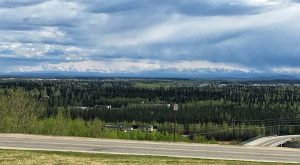Our first Alaskan Friday, May 18th, our group spent visiting the University of Alaska Fairbanks (UAF), where the first thing to give us goose bums was the view from the campus at gorgeous mountains of the Alaskan range. The first part of the day was dedicated to mathematics and related to math topics. Few professors, whose papers we have read earlier in the class, gave talks on the areas of their studies. One of the most exciting talks for me was by Dr. Vladimir Alexeev. He focused on describing how changes in Arctic area, such as declined sea ice and warm wind storms, have affect on the lower 48 (this is how Alaskan call states that locate on a lower continental part of America), causing cold mid-latitude winters. Warm winter events, winter days when temperature can reach up to 14 degrees Fahrenheit, are a normal part of Arctic, however, they become more frequent and last longer than they did even few decades ago.
After the talk I was pretty impressed by the information we learned and so I decided to find out more about it. I looked at NASA website that stated that fall and winter are crucial times for Arctic as sea ice grows and becomes thicker at this time, that’s why any increased winter air temperatures can impede ice growth and accelerate the effects of global warming. Few studies by Geophysical Research Lettersshowed that since 1980 an additional warming events occur each winter at the North Pole; and average length of each event has grown from fewer than two days to nearly two and a half days. Another important finding from 2015-2016 is the increase in temperature to nearly 3.6 degrees Fahrenheit from the previous winter (NASA Official, 2017).
After some homemade lunch, it was time for biology students to have fun and for us, math students, to learn about boreal forest and plants that can be found here. We had a tour by Teressa and Katie, field scientists whose papers our tour mates had read at the biology class. They guided us through woods of campus, showing and teaching about various plants of the Alaskan boreal forest. I don’t know almost anything about native species of plants so I found it pretty interesting to learn new things such as differences between white and black spruce, identification of Labrador tea, and a chance to try some cranberries that were hidden between leaves and moss. After some time of walking, we came into a part of forest that was not touched by humans. It was an area covered with a thick layer of moss, small bushes, and pretty short and thin spruces. Katie and Teressa prepared a challenge for us that required us to dig into the ground until the permafrost layer or layer of ground that would be equal to 0o C. Using scientific equipment, my group was finally able to drill into the ground after really tiring work as the ground contained ice practices and was really hard to work with. It took us approximately 30-40cm to reach the layer that was equal to 0 degrees Celsius. After that we also collected some information about spruces in that area. Due to small size and diameter of trees, we all assumed that these trees were pretty young, however, data collected by drilling into the trees’ outer and inter cores showed that these trees were approximately 80 years old and it was concluded by our group that the size was effected by small amount of nutrients in the ground and a cold climate.
Right after that we went to another area of the woods that was affected by human activity earlier in time. In the beginning of 20thcentury, agricultural department of the UAF decided to conduct few experiments and convert the boreal ground into farming land. When we got into that area of the woods it was hard to say that we walked only for 2 minutes and just crossed a road. The area looked completely different: dry, no moss or spruce, and only birch trees. However, the biggest difference was in the ground landscape as it consisted of a lot of small hills. We conducted same experiments as at the previous stop. However, drilling here was much easier and after some time of drilling we gave up as we drilled more than a meter downwards and temperature did not really change from the surface layer temperature of approximately 20 degrees Celsius.
Later Katie and Teressa told us why there is such a big differences in two areas that initially were alike but became so different after human activities. Moss is an important factor of a boreal forest. When it covers the surface, it protects the permafrost layer in the ground, keeping it cool and absorbing sunlight. And when people took the covering moss layer, ice ridges in the ground began to melt causing the formation of the hills.







So glad we could be out with you! It was so much fun that you had read Spellman and Hollingsworth papers on boreal forest plant community ecology from our Bonanza Creek LTER work before you met us. Please share all that you learned here in Alaska with your friends and family!
Warm regards,
Katie Spellman